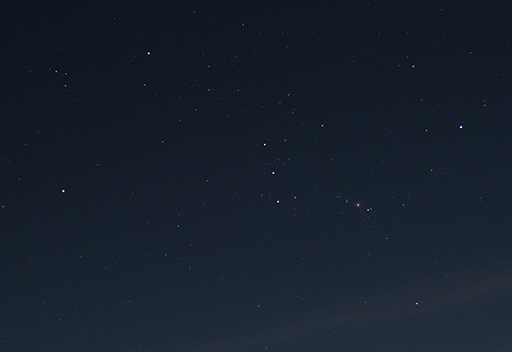2.1 The differing colours of stars
Earlier in the course, you studied the constellation of Orion, first in Stellarium during Week 1 and then as an image taken from Tenerife in Week 3. Let’s now take another look at Orion, this time concentrating on the colours of the two brightest stars, Rigel and Betelgeuse.
Activity 2 Colours in Orion
In this exercise you will compare the colours of stars in this image of Orion. The exercise will also allow you to practise matching up stars using an image in Stellarium or on a star chart, a skill that you will need for the variable star activity in later weeks.
Full resolution image here [Tip: hold Ctrl and click a link to open it in a new tab. (Hide tip)]
- First, look at the four bright stars forming the approximately rectangular outline of the main body of Orion.
What do you notice about the colours? Is one of the stars different from the others?
Answer
Three of the stars are a similar white colour, but the leftmost star in the rectangle is a more orange-red colour.
- Now identify the two brightest of these stars: Rigel, at the top right of the rectangle, and Betelgeuse, which is the leftmost of the four bright stars making up the main rectangle of the constellation.
- To help you identify these two stars correctly, open Stellarium and make sure that the location is still set to Tenerife. Find Orion and adjust the view so that it approximately matches the image above (to help you set the date and time correctly, note that the image in Figure 2 was taken from Tenerife in early November, facing east, at just before midnight).
- Using the Stellarium display, make sure that you have identified which star is Rigel and which is Betelgeuse in Figure 2.
- Compare the colours of these two stars in the Stellarium display and in the image.
Now that you are certain that you are looking at the correct stars, what do you notice about the colours of Rigel and Betelgeuse? What does this tell you about the temperatures of these stars?
Answer
Rigel is a blue-white star, meaning that it is very hot, whereas Betelgeuse is a reddish-orange colour, indicating that it is relatively much cooler. Betelgeuse is in fact an example of a red giant star and you will learn more about these in the next section. It is also an example of a variable star, and these will be examined in more detail next week.

